This has been a weird November. Whether it was a beautiful bright blue sky highlighting the last of the fall leaves on a warm day at the beginning of the month or an end of the month snow shower, I’ve enjoyed getting out and making little nature-related discoveries in my yard and nearby community. This week I wanted to take a minute and share a few of those discoveries with you.
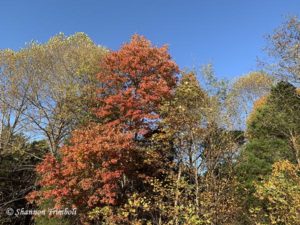
We had some beautiful days at the beginning of the month. Bright blue skies. Warm temperatures. And the last of the fall leaves. Perfect days to just step away from everything and enjoy the beauty around us.
As I was walking through the yard one day, I looked down and saw this wolf spider. If you look closely, you’ll see that her back is covered with baby spiderlings. Mother wolf spiders give their babies piggy back rides until they are old enough to take care of themselves. There are several species of wolf spiders, but they all exhibit this behavior. I believe that this one is either a rabid wolf spider (Rabidosa rabida) or a dotted wolf spider (Rabidosa punctulata). The babies are covering up the markings you need to see in order to distinguish between those two species.
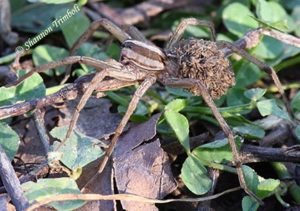
This month I was given some Allegheny chinquapin and American hazelnuts to plants. I am very grateful for these and am excited to try and grow them from seed. We always think of spring as the time for things to germinate and sprout. However, that’s not always the case. Some of our nut producing trees, like white oaks and Allegheny chinquapins, will germinate and send out a root sprout in the late fall or winter. We just don’t tend to notice them because the nuts are often covered by a blanket of fall leaves.
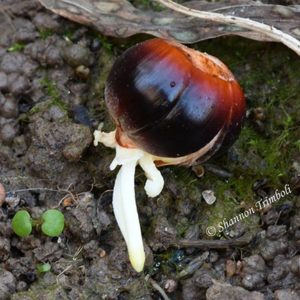
Apparently, my forsythia were very confused as to what season it is. They were in full bloom over Thanksgiving week. In addition to the forsythia, I also found dandelions, clover, goldenrod, and violets blooming on our property that week.
My husband found a beautiful prairie king snake on our property right before Thanksgiving. The colder weather means that most snakes have holed up for the winter, but we can still find a few, like this one, out and about on warmer days. Hopefully it found a good place to hunker down before the temperatures dropped. We like having kingsnakes around because of the natural pest control they provide. Kingsnakes eat other snakes (including venomous ones) and mice, among other things.
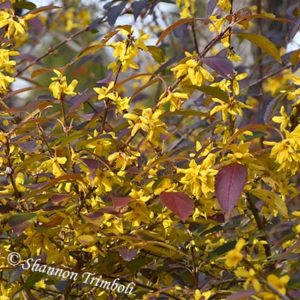
Ok, this one actually happened on Dec. 2, instead of in November, but I couldn’t wait until next month to share. It’s time to look for frost flowers! Frost flowers aren’t really flowers, and they aren’t really frost, but who says a name has to make sense? When the air temperature dips below freezing but the ground and plants haven’t frozen yet, frost flowers can form along the stem of certain plants like white wingstem (Verbesina virginica). They are the result of the sap that is still in the stem freezing. Since liquids expand as they freeze, the freezing sap splits the stem. The sap slowly leaks out the stem, freezing instantly as it hits the cold air and forming ribbons of ice known as frost flowers. Sometimes the frost flowers can form very intricate, almost delicate, curls and patterns, other times they form much sturdier clumps. Each one is unique. These are pictures that Mom sent me of the frost flowers in her backyard, including a close up of one of the flowers. Her frost flowers were better than mine that morning, but she also has more white wingstem than I do.
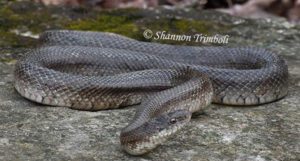
So, what interesting nature-related discoveries have you made in your yard and community over the last few weeks? I always enjoy hearing what others are finding too.
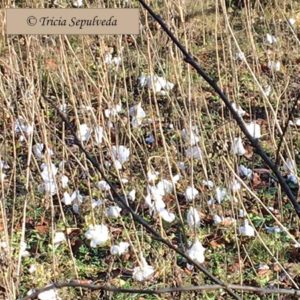
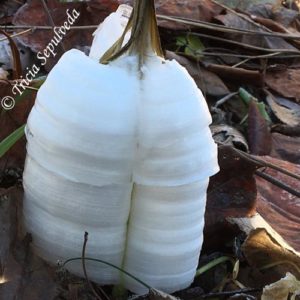

Backyard Ecology: Exploring Nature in Your Backyard
Nature isn’t just “out there.” It’s all around us, including right outside our doors. Hi, my name is Shannon Trimboli, and I am the host of Backyard Ecology. I live in southcentral Kentucky and am a wildlife biologist, educator, author, beekeeper, and owner of a nursery specializing in plants for pollinators and wildlife conservation. I invite you to join me as we ignite our curiosity and natural wonder, explore our yards and communities, and improve our local pollinator and wildlife habitat. Learn more or subscribe to my email list at www.backyardecology.net.

Leave a Reply